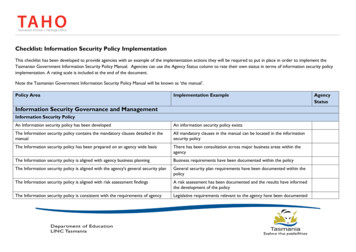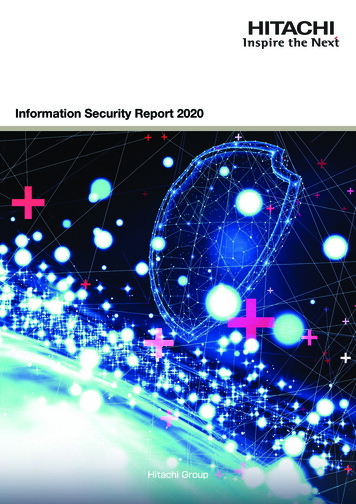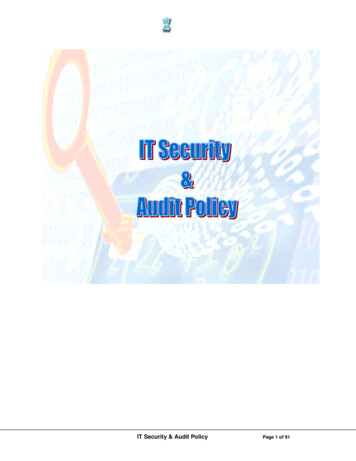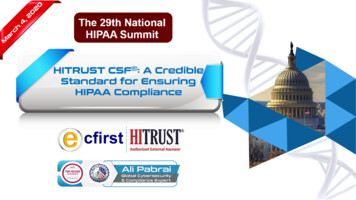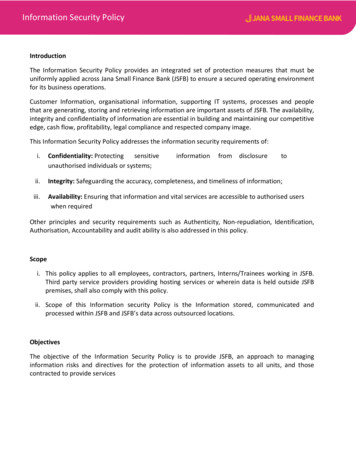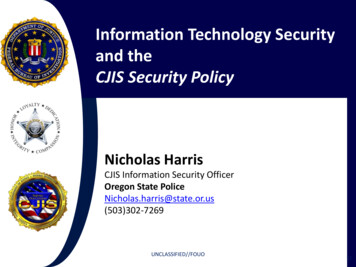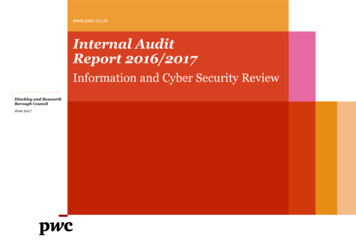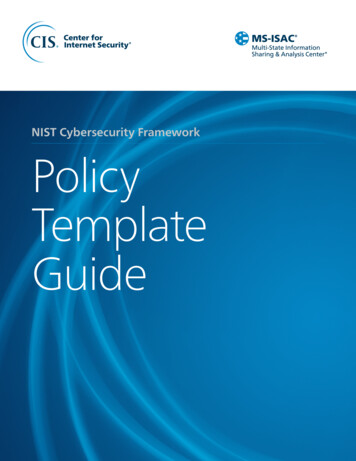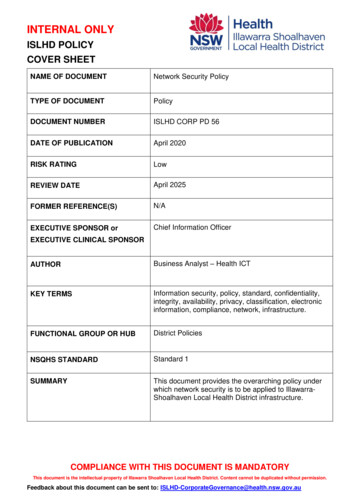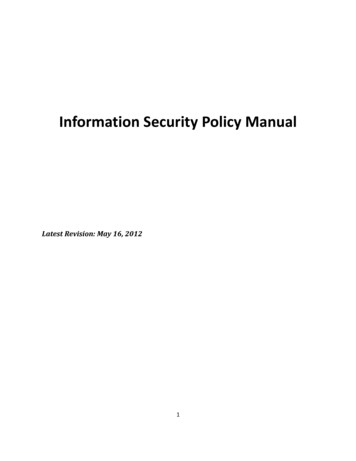
Transcription
Information Security Policy ManualLatest Revision: May 16, 20121
Table of ContentsInformation Security Policy Manual . 3Contact . 4Enforcement . 4Policies And Related Procedures. 51. ACCEPTABLE USE . 52. ACCESS CONTROL POLICY . 63. DATA ROLES AND RESPONSIBILITIES . 74. DATA CLASSIFICATION LEVELS . 85. CONFIDENTIAL DATA . 96. RISK MANAGEMENT . 127. SECURITY AWARENESS TRAINING . 138. INCIDENT RESPONSE . 149. BUSINESS CONTINUITY & DISASTER RECOVERY . 1510. SECURE WEB APPLICATION DEVELOPMENT. 16Resources . 17Information Security Glossary. 182
Information Security Policy ManualThe University of Connecticut developed information security policies to protect the availability,integrity, and confidentiality of University information technology (IT) resources. While these policiesapply to all faculty, staff, and students of the University, they are primarily applicable to Data Stewards,those that manage access to data and IT resources, and those who use University IT resources.The University expects all employees, students and users to adhere to the policies herein. No set ofpolicies can address all scenarios of IT security; therefore, these policies address the most commonaspects of security. We cannot eliminate malevolent behavior or irresponsibility, but we can guide usersand administrators toward responsible decisions and actions.The Chief Information Security Officer (CISO) manages the University’s information security activities.The CISO works in cooperation with University employees whose responsibilities address informationtechnology and information security.In order to protect resources from threats and ensure compliance with applicable laws and industrystandards, the University will manage and regulate networks and other IT resources.All employees must immediately report lost or stolen technology resources to the University PoliceDepartment (860-486-4800), the Information Security Office (860-486-8255), and the Office of theController (860-486-2937).The University’s IT resources, whether owned or contracted, will be configured to meet therequirements set forth in these policies. Agreements that involve a third party accessing or managingthe University’s IT resources shall comply with all of the requirements specified in these policies.Owners of IT resources are responsible for keeping computer systems protected from activities thatcould compromise the confidentiality, integrity, or availability of the resources. Owners shall performregular and timely computer maintenance, which includes, but is not limited to, installation of softwarepatches, and updates to malware and virus protection. The automatic implementation of patches andupdates at regular intervals will be utilized for all capable devices. Owners of IT resources should beaware of the business and availability requirements for their systems, and owners shall createappropriate documentation and processes to meet the requirements outlined in these policies.University managers should direct faculty and staff to the information security policies and discuss theimpacts and outcomes of the policies for their specific areas. Upon hire, employees will sign a“Statement of Policy Acknowledgement” which will be administered and maintained by the HumanResources department.The regulations of The Student Code remain applicable to students and their registered organizations,regarding information security:“Unauthorized possession, duplication, or misuse of University property or otherpersonal or public property, including but not limited to records, electronic files,telecommunications systems, forms of identification, and keys.” (Student Code, III.Proscribed Conduct, Section B, 16)3
ContactChief Information Security Officer, Jason Pufahl: Jason.pufahl@uconn.edu / (860) 486-3743Please email security@uconn.edu for questions, concerns or general feedback.Please email abuse@uconn.edu to report any security breaches or incidents.Please visit http://security.uconn.edu for more information.EnforcementViolations of information security policy may result in appropriate disciplinary measures in accordancewith local, state, and federal laws, as well as University Laws and By-Laws, General Rules of Conduct forAll University Employees, applicable collective bargaining agreements, and the University of ConnecticutStudent Conduct Code.For purposes of protecting the University’s network and information technology resources, theInformation Security Office may temporarily remove or block any system, device, or person from theUniversity network that is reasonably suspected of violating University information security policy.These non-punitive measures will be taken only to maintain business continuity and informationsecurity, and users of the University’s information technology resources will be contacted for resolution.Any individual who suspects a violation of this policy may report it to: The Information Security Office: (860) 486-8255 The Compliance Office in the Office of Audit, Compliance and Ethics: (860) 486-4526 Anonymously through the Reportline: (888) 685-2637 or 4
Policies And Related Procedures1. ACCEPTABLE USEThe Acceptable Use policy is intended to supplement the State of Connecticut Acceptable Use policy andapplies to all users of the University's computer and network resources.Information technology (IT) resources must be utilized respectfully and as authorized and designed.While utilizing University-owned IT resources, no user or administrator is authorized to engage in anyactivity that violates University policy or any illegal activity under local, state, federal or internationallaw.Users and administrators may not engage in any activity that interrupts personal productivity or theservice of any University resources. Users and administrators will not intentionally disrupt, damage, oralter data, software, or other IT resources belonging to the University or to any other entity. Thisincludes spreading viruses, sending spam messages, performing denial of service attacks, compromisinganother individual's ability to use IT resources, and performing system/network reconnaissance.Users of University systems shall not tamper with, disable, or circumvent any security mechanism,including software applications, login account controls, network security rules, hardware devices, etc.Users shall not introduce any prohibited information technology resources that could disrupt operationsor compromise security of the University’s IT resources.5
2. ACCESS CONTROL POLICYAll University information technology (IT) resources that store, process, or transmit Confidential orProtected data must require usernames and passwords for access.Data Stewards must authorize all individuals prior to their accessing IT resources that store, process ortransmit Confidential or Protected Data.Individual units are responsible for developing and implementing procedures for authorizing andgranting access to their IT resources that store, process or transmit Confidential or Protected Data.Data Stewards shall document all data access privileges, and will reevaluate access privileges when auser’s job assignment changes. When a user no longer requires data access or leaves the University forany reason, the Data Steward shall revoke the user’s access privileges. The user’s supervisor isresponsible for making appropriate and timely requests to the Data Steward for IT resource accountaccess modification.Individuals with access to Confidential or Protected Data may not share or redistribute this data withoutreceiving the expressed, prior consent of the Data Steward.Login Names and PasswordsData Administrators will configure systems and applications to meet the following requirements toauthentic users of IT resources that store, process or transmit Confidential or Protected Data: Data Administrators must assign each user a unique login name. Login names will have an associated password, which is required to minimally meet thestandards outlined in the University password standards.Users must not share account passwords with any other person.Review & ComplianceFor systems where Confidential Data is stored, processed, or transmitted, Data Stewards and DataAdministrators will review user access rights annually using a documented process.Data Stewards, or their designated representatives, shall ensure appropriate procedures aredocumented, disseminated, and implemented to ensure compliance with this policy.6
3. DATA ROLES AND RESPONSIBILITIESData Stewards oversee the proper handling of administrative, academic, public engagement, orresearch data. Data Stewards are responsible for classifying data according to the University’s dataclassification system, ensuring that appropriate steps are taken to protect data, and the implementationof policies and agreements that define appropriate use of the data. The Steward or his designatedrepresentatives are responsible for and authorized to: Approve access and formally assign custody of an information technology (IT) resource. Specify appropriate controls, based on data classification, to protect the IT resources fromunauthorized modification, deletion, or disclosure. The Steward will convey those requirementsto administrators for implementation and educate users. Controls shall extend to IT resourcesoutsourced by the university Confirm that applicable controls are in place to ensure appropriate level of confidentiality,integrity and availability Confirm compliance with applicable controls Assign custody of IT resources assets and provide appropriate authority to implement securitycontrols and procedures Ensure access rights are re-evaluated when a user’s access requirements to the data change(e.g., job assignment change)Data Administrators are usually system administrators, who are responsible for applying appropriatecontrols to data based on its classification level and required protection level, and for securelyprocessing, storing, and recovering data. The administrator of IT resources must: Implement the controls specified by the Steward(s) Provide physical and procedural safeguards for the IT resources Assist Stewards in evaluating the overall effectiveness of controls and monitoring Implement the monitoring techniques and procedures for detecting, reporting, and investigatingincidentsData Users are individuals who received authorization from the Data Steward to read, enter, or updateinformation. Data Users are responsible for using the resource only for the purpose specified by theSteward, complying with controls established by the Steward, and preventing disclosure of confidentialor sensitive information.7
4. DATA CLASSIFICATION LEVELSConfidential Data requires the highest level of privacy and may not be released. Confidential Data isdata that is protected by either: Legal or regulatory requirements (e.g., HIPAA) Contractual agreements (e.g., Non Disclosure Agreements)See the extended list of Confidential Data for common types of confidential data.Protected Data must be appropriately protected to ensure a lawful or controlled release (e.g.Connecticut Freedom of Information Act requests). This is all data that is neither Confidential or Publicdata (e.g., employee email).Public Data is open to all users, with no security measures necessary. Data is public if: There is either an obligation to make the data public (e.g., Fact Sheets), or The information is intended to promote or market the University, or pertains to institutionalinitiatives (e.g., brochures)8
5. CONFIDENTIAL DATAThe University prohibits unauthorized or anonymous electronic or physical access to informationtechnology (IT) resources that store, transmit, or process any of the following: University Confidential or Protected Data Personally identifiable information (PII) Protected health information (PHI) or electronic protected health information (ePHI) Credit Card data Any other regulated data.StorageConfidential Data storage will be limited to the minimum amount, and for the minimum time, requiredto perform the business function, or as required by law and/or State of Connecticut Data Retentionrequirements.University IT resources that are used for storage of Confidential Data shall be clearly marked to indicatethey are the property of the University of Connecticut. Servers that store Confidential or Protected Datashall not be used to host other applications or services.The University prohibits the storage of encrypted or unencrypted Credit Card data in physical orelectronic form. Confidential Data may not be stored on personally owned IT resources. Users ofportable devices will take extra precautions to ensure the physical possession of the portable device andthe protection of the University’s Confidential and Protected Data.The University’s Confidential or Private Data may not be accessed, transmitted, or stored using publiccomputers or via email.System Administrators shall implement access controls on all IT resources that store, transmit, orprocess Confidential or Protected Data, minimally supporting the requirements defined in the AccessControl Policy.ProceduresEach calendar year, Data Users who are capable of viewing, storing, or transmitting ConfidentialData shall complete the Information Security Awareness Training Program.University employees will perform monthly scans and review results in order to locate andremove PII on each computer under their control. Storage of PII on desktop or laptop computersrequires:1. Explicit permission from the Data Steward,2. Separate accounts for all users with strong passwords required for all accounts,3. Whole disk encryption enabled,4. Security logging and file auditing enabled,5. Computer firewall enabled and logging,6. Automatic operating system patching and antivirus software updates,7. Automatic screen lock after a period of inactivity,8. Restricted remote access methods, such as remote desktop and file sharing.9
EncryptionTo maintain its confidentiality, Confidential Data shall be encrypted while in transit across open orinsecure communication networks, or when stored on IT resources, whenever possible. Stored data mayonly be encrypted using approved encryption utilities. To ensure that data is available when neededeach department or user of encrypted University data will ensure that encryption keys are adequatelyprotected and that procedures are in place to allow data to be recovered by another authorizedUniversity employee. In employing encryption as a privacy tool, users must be aware of, and areexpected to comply with, Federal Export Control Regulations.Activity Logging & ReviewIT resources that store, access, or transmit Confidential Data shall automatically log activity intoelectronic log files. Logging includes system, network, application, database, and file activity, wheneveravailable, and includes creation, access, modification, and deletion activity.Log files shall be retained electronically for the duration necessary to meet the requirements defined bythe State Data Retention schedule S6.Systems and devices that process, store, or transmit data that are protected by federal regulations (e.g.,HIPAA) or by industry requirements (e.g., PCI-DSS) must submit system-generated logs to theInformation Security Office’s central logging system.ProceduresSystem administrators and/or Data Stewards shall examine electronic logs, access reports, andsecurity incident tracking reports, minimally every 30 days, for access control discrepancies,breaches, and policy violations. Log harvesting, parsing and alerting tools can be used to meetthese requirements.Service ProvidersDepartments shall take steps to ensure that third-party service providers understand the University’sConfidential Data Policy and protect University’s Confidential Data. No user may give a Third Partyaccess to the University’s Protected or Confidential Data or systems that store or process Protected orConfidential Data without a permission from the Data Steward and a Confidentiality Agreement in place.Access to these resources must be handled as defined in the University’s Access Control Policy.Physical SecurityEach University department that stores, processes, or transmits Confidential Data will maintain a FacilitySecurity Plan that contains the processes necessary to safeguard information technology resources fromphysical tampering, damage, theft, or unauthorized physical access. Departments will take steps toensure that all IT resources are protected from reasonable environmental threats and hazards, andopportunities for unauthorized physical access.Access to areas containing Confidential Data information must be physically restricted. In departmentswith access to PHI or Credit Card data, all individuals in these areas must wear a University-issuedidentification badge on their outer garments so that both the picture and information on the badge areclearly visible.10
DisposalSystems administrators will ensure that all data stored on electronic media is permanently destroyedprior to the disposal or transfer of the equipment. The steps taken for the destruction of data will followthe University computer surplus procedures.Confidential Data maintained in hard copy form will be properly disposed of using University-approvedprocesses when no longer required for business or legal purposes.Access to areas such as data centers, computer rooms, telephone equipment closets, and networkequipment rooms will be restricted to authorized personnel only. Areas where Confidential Data isstored or processed shall be restricted to authorized personnel and access to these areas shall belogged.11
6. RISK MANAGEMENTThe Information Security Office (ISO) is responsible for developing a process for conducting RiskAssessments for the University’s information technology (IT) resources.The results of the Risk Assessment will be used to determine security improvements resulting inreasonable and appropriate levels of risk acceptance and compliance for each system.Results indicating an unacceptable level of risk shall be remediated as soon as possible, as determinedby specific circumstances and the timelines decided collectively by the Chief Information Security Officer(CISO), Data Steward, and the Dean, Director or Department Head.Results of all risk assessments shall be treated as Confidential Data and secured appropriately.ProceduresEach department is responsible for ensuring that a Risk Assessment is performed biennially foreach of the information technology resources in their respective areas. Risk Assessments willalso be conducted when there is an environmental or operational change that may affect thesecurity of Confidential Data.12
7. SECURITY AWARENESS TRAININGThe University Information Security Office (ISO) maintains an Information Security Awareness Training(ISAT) program that supports the University employees’ and students’ needs for regular training,supporting reference materials, and reminders to enable them to appropriately protect Universityinformation technology resources.Data Stewards are responsible for ensuring that any user requesting access to Confidential Data hascompleted the ISAT program before allowing access to that data.The ISO will provide periodic Information Security reminders and updates, posted on the UniversityInformation Security website and using email lists, where appropriate.Users with access to Confidential Data that is protected under Federal Regulations (e.g., HIPAA, etc.) orby industry standards (e.g., PCI-DSS) must complete the ISAT program annually.Departments shall maintain appropriate documentation of attendance/completion of the ISAT trainingwhere data security training is required by applicable regulatory or industry standards.13
8. INCIDENT RESPONSEThe Information Security Office (ISO) will establish, document, and distribute an Incident Response Planto ensure timely and effective handling of security incidents involving information technology (IT)resources.University employees with IT responsibilities are responsible for understanding and following theUniversity’s Incident Response Plan.Suspected and confirmed security incidents, their resolution steps, and their outcomes shall bedocumented by those directly involved. The ISO will ensure that incidents are appropriately logged andarchived.ProceduresAll employees must immediately report lost or stolen technology resources to the UniversityPolice Department (860-486-4800), the Information Security Office (860-486-8255), and theUniversity’s Office of the Controller (860-486-2937).14
9. BUSINESS CONTINUITY & DISASTER RECOVERYEach University department will maintain a current, written and tested Business Continuity Plan (BCP)that addresses the department’s response to unexpected events that disrupt normal business (forexample, fire, vandalism, system failure, and natural disaster).The BCP will be an action-based plan that addresses critical systems and data. Analysis of the criticalityof systems, applications, and data will be documented in support of the BCP.Emergency access procedures will be included in the BCP to address the retrieval of critical data duringan emergency.The BCP will include a Disaster Recovery (DR) Plan that addresses maintaining business processes andservices in the event of a disaster and the eventual restoration of normal operations. The BCP and DRPlan will contain a documented process for annual review, testing, and revision. Annual testing of theBCP will include desk audits, and should also include tabletop testing, walkthroughs, live simulations,and data restoration procedures, where appropriate. The BCP will include measures necessary toprotect Confidential Data during emergency operations.Data Administrators are responsible for implementing procedures for critical data backup and recoveryin support of the BCP. The data procedures will address the recovery point objective and recovery timeobjectives determined by the Data Steward and other stakeholders.15
10. SECURE WEB APPLICATION DEVELOPMENTDepartments will ensure that development, test, and production environments are separated.Confidential Data must not be used in the development or test environments.All applications must be tested for known security vulnerabilities (such as the OWASP Top Ten) prior tobeing placed in production and at regular intervals thereafter.Production application code shall not be modified directly without following an emergency protocol thatis developed by the department, approved by the Data Steward, and includes post-emergency testingprocedures.Web servers that host multiple sites may not contain Confidential Data.All test data and accounts shall be removed prior to systems becoming active in production.The use of industry-standard encryption for data in transit is required for applications that process,store, or transmit Confidential Data.Authentication must always be done over encrypted connections. University enterprise CentralAuthentication Service (CAS), Shibboleth, or Active Directory services must perform authentication forall applications that process, store, or transmit Confidential or Protected Data.Web application and transaction logging for applications that process, store, or transmit ConfidentialData or Regulated Data must submit system-generated logs to the Information Security Office’s centrallogging system.Departments implementing applications must retain records of security testing performed in accordancewith this policy.16
ResourcesBelow is a list of resources that are referenced throughout the information security policies. Theseresources, templates, and procedures support the information security policiesReference Information OWASP Top TenState of Connecticut Acceptable Use PolicyState of Connecticut Data Retention schedule S6University Information Security Office WebsiteProcedures and Standards Data Destruction ProceduresFederal Export Control RegulationsIdentity Finder web siteIncident Response MethodologyList of Prohibited IT ResourcesSecurity Patch GuidelinesUniversity password standardsResources & Services Central Stores Shredding ServiceOnline Security Awareness TrainingSecurity Risk Assessment ToolUniversity Centralized Logging ServiceTemplates and Guides Business Continuity Plan TemplateFacility Security PlanSample Confidentiality Agreement17
Information Security GlossaryAccess Controls: The technology, processes, and procedures used to limit and control access toinformation technology (IT) resources; these controls are designed to protect against unauthorized entryor use.Accounts: User accounts are the means of access for real people to a computer system, and provideseparation of the users’ activities with the system environment, preventing damage to the system orother users. User accounts are assigned a usernameActive Directory: A software system that stores, organizes and provides access to information in adirectory created by Microsoft. It is responsible for authenticating and authorizing all users andcomputers within a network.Administrator: See System AdministratorAuthentication: The act of verifying the identity of a user and the user’s eligibility to accesscomputerized information.Authorization: The function of specifying access rights to resourcesAvailability: The state of a system in a functioning conditionBusiness Continuity Plan (BCP): A document describing how an organization responds to an event toensure critical business functions continue without unacceptable delay or change.CAS: Known as Central Authentication Service, CAS permits a user to access multiple applications whileproviding their username and password only once.Chief Information Security Officer (CISO): Head of the Information Security OfficeComputer Maintenance: Tasks that must be performed on computers in order to keep them running atoptimal efficiency. These tasks include applying security patches, running and maintaining antivirussoftware, and keeping the computer and data secure.Confidentiality: SecrecyCredit Card Data: Data that identifies a credit card account. This data includes primary account numbers(PAN), service codes, expiration date, magnetic stripe or storage chip data, and card validation codes.Critical Systems And Data: Systems and data that are essential to the operations of the University of toa specific department.Data: Records and information in a form suitable for use with a computer.18
Data Administrators: People who are responsible for applying appropriate controls to data based on itsclassification level and required protection level. These people are usually system administratorsData Stewards: People with the responsibility of ensuring the proper handling of administrative,academic, public engagement, or research data.Data Restoration Procedures: The process used to reinstate data that has been backed up.Data Users: People that read, enter, or update data.Desk Audits: The act of reviewing documentation to verify technical and procedural details.Development Environment: Software staging system, where development takes place, that is separatefrom the actual systemDisaster: A negative event that lasts longer than the maximum tolerable downtimeDisaster Recovery (DR) Plan: A document that outlines how the University will respond to a disaster andresume critical business functions within a predetermined period of time with minimum amount of loss.Electronic Protected Health Information (ePHI): Electronic confidential patient information that mustbe secured against unauthorized exposure as per HIPAA.Encrypted Data: Data that has undergone the process of encryptionEncryption: A technique used to transform plain text so it is unintelligible but recoverable.Encryption Key: The input into an encryption algorithm that allows the data to be encrypted.File Auditing: The logging of opening, modifying, or deleting files on a computer.File Sharing: Distribu
The Chief Information Security Officer (CISO) manages the University's information security activities. The CISO works in cooperation with University employees whose responsibilities address information technology and information security. In order to protect resources from threats and ensure compliance with applicable laws and industry
